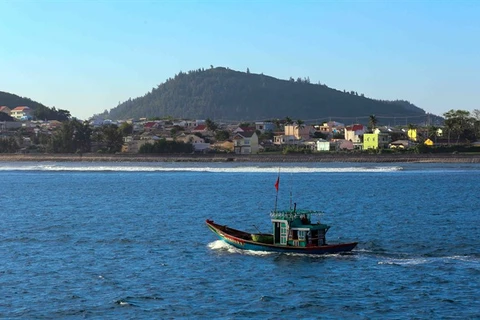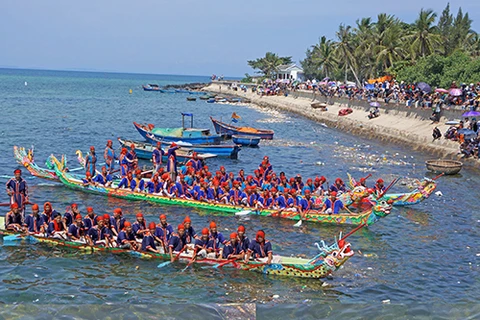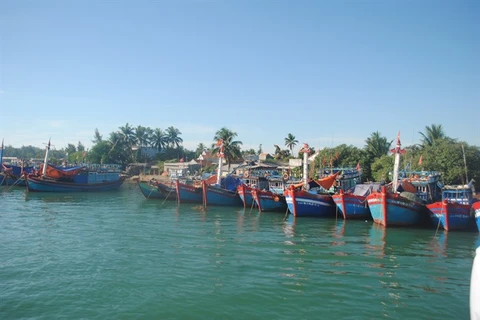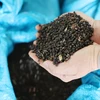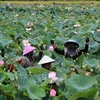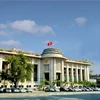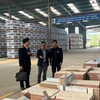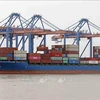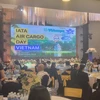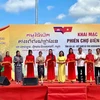Quang Ngai (VNA) – Both residents and visitors to Ly Son Island in the central province of Quang Ngai are concerned about a construction boom that can destroy the unique natural landscape on the island.
The island is becoming an attractive destination for domestic and foreign visitors, resulting in high demand for accommodations and other services.
According to the People’s Committee of Ly Son Island District in the central province of Quang Ngai, about 45,000 tourists came here in 2015, spending 546 billion VND (nearly 24.5 million USD).
It is expected that the number of tourists will reach 80,000 by 2020, bringing 1,200 billion VND (53.8 million USD) to the island.
Hundreds of restaurants and hotels were built or are under construction with differing architectural styles.
Tran Hoang, a local resident in An Vinh Commune, said that ten years ago the island was very wild, with spectacular natural scenery.
But beginning over two years ago, the landscape has been gradually destroyed by unplanned buildings.
"The fragmented tourism development is worsening the natural landscape. Many cultivated areas are being turned into construction land for tourism," Hoang added.
Further, bars, restaurants and hotels have been illegally built in the centre of the island at famous tourist spots, such as in Hang Cau, Hang Co, and Cong To Vo.
After holidays, the island is scarred by rubbish.
The provincial Department of Culture, Sports and Tourism has reported the situation to the provincial authority.
The report noted that the lack of direction on massive building has negatively affected the island, particularly the environment and beautiful beaches.
Huynh Thi Phuong Hoa, deputy director of the department, told the Nguoi Lao Dong newspaper that poor supervision by local authorities caused the problems, though the province has approved an overall plan for tourism on the island.
To solve this problem, provincial inspection teams are to examine land management and construction, which were reported to have affected the landscape of the entire island.
Further, cases of using planned tourism land for other purposes would be strictly dealt with, according to the provincial party committee.
The committee has also directed local authorities to review and temporarily stop carrying out tourism projects that are not funded by the State budget, to wait for more specific plans, said Le Minh Huan, head of the office of the provincial People’s Committee.
Relevant agencies were also required to review and propose plans to adjust construction projects, aiming to ensure the well-being of the ecosystem and natural landscape.
“The prolonged situation will risk breaking the well-endowed natural landscape of the island in the future,” Tran Van Minh, Deputy Secretary of provincial Party Committee said.
Ly Son district lies 18 nautical miles off the Vietnamese coast and covers an area of 10 square kilometres. It includes three communes: An Hai, An Vinh and An Binh.
The island district has a population of approximately 2,100. The majority of residents earn a living from fishing and farming garlic and spring onion.
Ly Son is striving to become a maritime economic centre by 2025, with a focus on tourism and aquaculture.
Archaeologists found relics of Sa Huynh culture on the island, which date back to 3,000 years ago. Starting in the 16th century, a number of ethnic groups migrated to Ly Son from the mainland and have inhabited the island ever since.
The island boasts numerous forms of intangible cultural heritage, such as traditional boat races and the Hoang Sa Soldier Feast and Commemoration Festival, which was recognised as part of the national cultural heritage in April, 2013. In the past, during the Nguyen Dynasty, the festival was organised to choose the healthiest men for a team of Hoang Sa soldiers.
The festival, which has been held for more than 300 years, is organised between the fourth and eighth day of the Lunar New Year.-VNA
VNA

